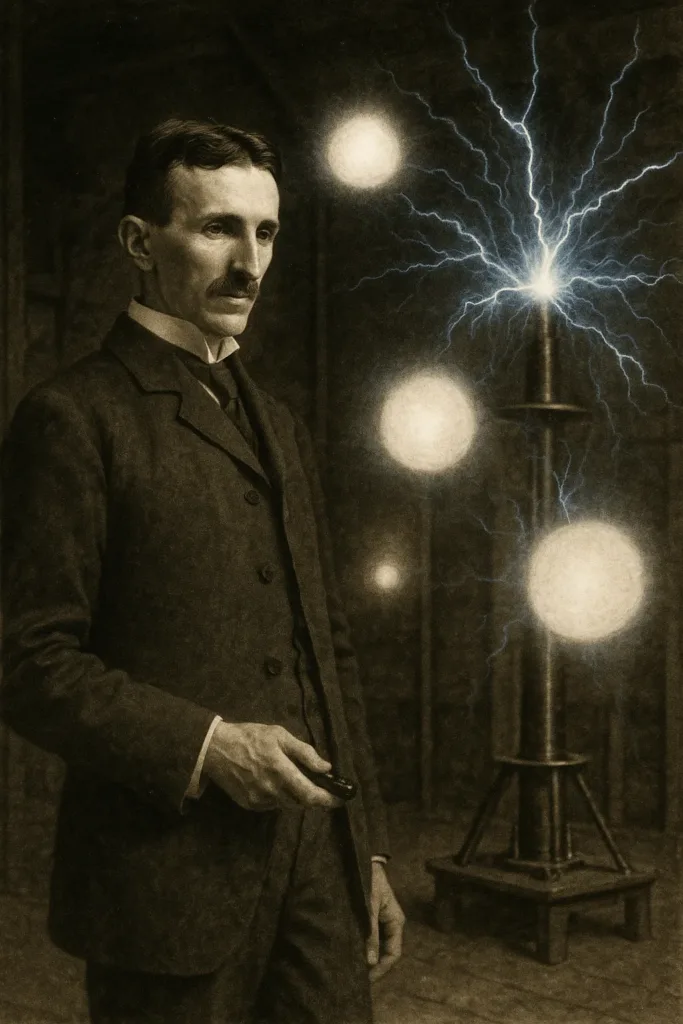Return to High-Voltage Experiments
After the financial collapse of the Wardenclyffe Tower, Nikola Tesla returned to laboratory work. There, in nights filled with ozone and bluish sparks, he encountered a phenomenon that still amazes physicists today — stable ball lightning. Unlike modern experiments, where plasmoids last only fractions of a second, Tesla claimed he could sustain glowing spheres for tens of seconds, even up to a minute.
Tesla on the Origin of Ball Lightning
“During experiments with high frequencies and enormous voltages, glowing spheres often appeared, resembling stable plasma structures… These spheres were not ordinary electrical sparks, but something entirely different — as if they were alive.”
— Research diary, Colorado Springs, 1899.
In an interview with the New York Herald (1911), Tesla further explained:
“These are concentrated packets of energy, surrounded by swirling electromagnetic fields… They appear in nature during storms, but I discovered how to create them in the lab.”
And in a private letter to the editor of Scientific American (1935), he revealed a key formula:
“The key lies in the combination of three factors: (1) wavelengths that resonate with the gas, (2) the rate of change of the field, and (3) the absolute voltage… only then does a balance occur between the internal pressure of the plasma and the external electromagnetic ring.”
Patent Clue – A Method for Controlling Plasmoids
📜 US Patent 1,266,175 (1918) – “Method of Controlling Atmospheric Electricity”
Tesla described how he generated “gaseous explosions in the form of glowing spheres” using:
- high-frequency waves,
- vacuum chambers filled with argon, nitrogen, or mercury vapor.
“These plasmoids do not obey the usual laws of electrical discharge but behave as self-sustaining entities, stabilized by a rotating electromagnetic field around them.”
What Did Tesla Know That We’re Only Beginning to Understand?
| Tesla’s Hypothesis | Modern Confirmation / Hypothesis |
|---|---|
| Role of specific gases (argon, Hg) | Noble gases are now used to stabilize microplasmas |
| Nonlinear EM effects | Plasma physics uses nonlinear solitons and vortices |
| “Living” plasma dynamics | Self-organizing plasmoid vortices in modern models |
Theories Behind Tesla’s Stable Ball Lightning
- Plasma + Electromagnetic Resonance – plasma solitons maintain shape due to resonant EM fields.
- Metal vapor from electrodes – copper/tungsten may form a protective shell slowing down plasma cooling.
- Thermal balance – precise pressure-to-temperature ratios prolong the lifespan of the sphere.
Modern Attempts at Replication
| Lab / Year | Technique | Duration of Sphere |
|---|---|---|
| PEAR Lab, Princeton | Microwaves in vacuum | ~1 s |
| MIT, 2023 | Femtosecond lasers in air | milliseconds |
| HF pulsed methods | Tesla coil + modern plasma control | still unstable |
Why Are We Missing Tesla’s “Exact Recipe”?
- The 1895 fire – key blueprints lost in the South Fifth Avenue lab.
- FBI seizure in 1943 – some documents classified as “Confidential.”
- Tesla’s secrecy – experiences with Marconi made him cautious; he concealed details awaiting commercialization.
Conclusion: Science Is (Still) Chasing Tesla’s Lightning
Tesla saw, with his own eyes, stable, self-organizing “balls of energy” — a phenomenon modern plasma physics is only beginning to model. A combination of ultra-high voltage, resonant frequencies, and carefully chosen gases forms a plasmoid vortex that could one day revolutionize plasma control and novel energy sources.
MilovanInnovation will continue to follow this field. In the next and final part of this series, we present the grand finale — a synthesis of Tesla’s legacy and his impact on humanity’s future.


Leave a Reply to Milos Janicijevic Cancel reply